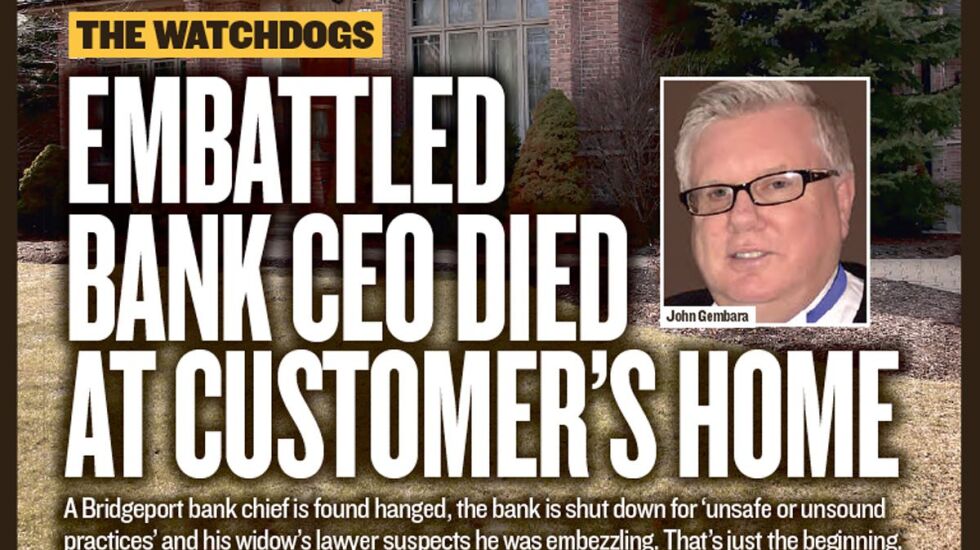
For years, a small, politically connected bank in Bridgeport ran newspaper ads offering generous interest rates on certificates of deposit that attracted customers from across the city and suburbs who put in millions of dollars.
They had no idea their cash deposits were fueling an embezzlement scheme overseen by John F. Gembara, who was the president, chief executive officer and biggest shareholder of Washington Federal Bank for Savings — until he was found dead in a customer’s bedroom 12 days before federal regulators shut down the family-run bank in December 2017 after discovering massive fraud.
Most depositors have gotten back all of their money from the Federal Deposit Insurance Corp., which paid $140 million to cover as much as $250,000 for each person on an account.
But four dozen customers — including several who since have died — lost as much as $312,525 each because their accounts exceeded the FDIC’s insurance guarantee limit.
That’s according to records filed in the embezzlement trial of Marek Matczuk, who was found guilty last month of embezzling $6 million. Matczuk owns the Park Ridge home where Gembara was found dead with a rope wrapped around his neck and the railing of a spiral staircase.
Authorities say Gembara killed himself. But his widow, her attorney and others have said they suspected he was killed as federal regulators began unraveling the embezzlement scheme that brought down the bank.
Among the customers who lost money is a Glencoe physician who worked in the Chicago Medical District on the West Side and says he often ate lunch in Little Italy, where the bank had a branch office offering “really good rates” on certificates of deposit.
The doctor says that, over time, he “was chasing CD rates,” depositing a total of $2.7 million in several CDs at Washington Federal.
Then, he says, he got a call from the bank’s branch manager.
“She told me they were in trouble,” the doctor says. “She told me she thought the guy killed himself. I raced down there. I got the money out, as much as I could.
“She said I was 100% insured. When I went to the FDIC, they said that wasn’t the case. It turns out [the branch manager] didn’t know the FDIC limits and how it works. She apologized to me. But it doesn’t help me get my money back.
“It was a corrupt enterprise. I thought my money was as safe as it could be in a bank.”
Seven days after regulators closed Washington Federal, government records show, the doctor got a check for $2,542,695. He also filed a claim for $174,717 with the FDIC, which has paid him $74,862 as it has continued to work to recover money. He’s still out $104,846.
The Sun-Times isn’t publishing the name of the doctor or any other depositors with pending claims because there’s no indication they knew about the embezzlement scheme that brought down the bank that Gembara’s family ran for three generations.
Records show Gembara had been looting the bank for more than a decade.

FDIC officials won’t talk about the outstanding claims as the investigation of the failed bank continues.
Fourteen people charged in connection with the bank have been convicted. Among them: former Ald. Patrick Daley Thompson (11th), who was found guilty of lying to regulators about the money he got from Gembara and had to resign his Chicago City Council seat representing his family’s longtime Bridgeport stronghold.
Two others, including a bank employee, have deferred-prosecution agreements under which the criminal charges against them could be dismissed in exchange for their cooperation with federal authorities.
The FDIC has recovered about $59 million and could get more after U.S. District Judge Virginia Kendall sentences the bank officials, employees and others involved in the embezzlement. They could be ordered to do time in prison and to pay restitution to the FDIC.

Bank’s ‘smooth operators’
Any more money the FDIC recovers could be shared with customers who have pending claims.
Those include the estate of a former trade association president from the South Loop who put all of his money in the bank despite his daughter’s suspicions.
“He was originally introduced to them because they advertised in the newspaper that they had higher CD rates,’’ the daughter says. “They would always match other banks’ rates.
“I remember saying to my dad, ‘Doesn’t that raise alarm bells that they are offering so much better rates?’ He said, ‘Don’t worry, I know the president’s sister’” — referring to Janice Weston, a bank vice president who has pleaded guilty in the scheme.
“I went to the bank with him because I was concerned,” the daughter says. Weston “was the face of the bank to my father. She created that personal relationship with my father. They needed cash. They were smooth operators, and they figured out a model to get that cash from people.
“One day, my dad wakes up, and the FDIC called him on the phone and said, ‘We shut down the bank.’ Almost before he could be worried about it, they replaced [most of] his funds. He kept saying to my husband and I, ‘You kept saying it was too good to be true. And I should have listened to you.’”

He got back most of the money but filed a claim with the FDIC because one account exceeded the maximum insurance guarantee by $56,674. His daughter says the bank assured him that the account he had opened with his late wife was fully insured. It wasn’t.
Her father died in June 2020 at age 87. The FDIC has been able to reduce his claim to $34,913. But his daughter isn’t sure the rest will ever be repaid.
“It was worrisome and painful, not just financially but emotionally,” she says. “No one wants to feel they were scammed.”
Gembara was chairman of the bank’s board of directors, which included his sister and three others:
- George Kozdemba, a retired electrician with the Metropolitan Water Reclamation District of Greater Chicago.
- William M. Mahon, a former high-ranking City Hall official and member of the Daley family’s 11th Ward Regular Democratic Organization.
- Lester Stepien, a meatpacking company comptroller who is cooperating with prosecutors.


Like Weston, Kozdemba and Mahon face possible prison sentences along with five bank employees and four customers, including Robert M. Kowalski, a lawyer and longtime friend and business partner of Gembara who was convicted in March of embezzling $8 million from Washington Federal and concealing more than $560,000 in assets when he went bankrupt.

Bank regulators ‘negligent’
About three months before federal regulators shut down the bank, a University of Illinois Chicago professor opened an account at Washington Federal’s Little Italy branch.
“The bank was right down the street from my office,” says the professor, who has since retired. “It was supposed to be a joint account, and instead it was just me. I was trying to straighten that out when the bank closed.”
He got a check for $250,000 — the FDIC’s maximum insurance payment for an individual account holder. He filed a claim for the remaining $106,299. The FDIC has since sent him four payments, reducing his claim to $62,556.
The retired professor says he wouldn’t have had to file that claim if the bank had done what he asked for and created a joint account, which would mean the FDIC would have insured it for up to $500,000.
“I can’t understand why the [regulators] were so negligent,” allowing the scheme to go undetected for years, the former professor says.
The bank’s last federal audit began Oct. 31, 2017. On Nov. 28, 2017, federal regulators directed the bank board to suspend Gembara.

Banker’s relatives got their money
The following day, government records show, Gembara’s relatives began withdrawing their money from the bank.
On Dec. 3, 2017, Gembara was found dead at Matczuk’s home.
On Dec. 15, 2017, regulators closed the bank.
Sixteen days later, records show, Gembara’s wife, Therese Gembara, who hasn’t been implicated in the scheme, got 10 checks totaling $257,186.
Her attorney has said she doubts her husband killed himself.
Government records don’t show any Gembara relatives filing claims with the FDIC.
Another bank customer who did file a claim was a woman, now 83, who lives in a condominium in Portage Park.
“We were all victims,” the woman says of herself and other bank customers. “Wish I never heard of this bank. I wish I never went there. I got to be a customer because I saw an ad in the paper a few months before the bank closed.”
She got a check for $250,000 a month after the bank failed. She also filed a claim with the FDIC for another $143,748 and has collected $60,000 of that.
“I would be delighted if I got more money,” the woman says. “But I would be very surprised.”








